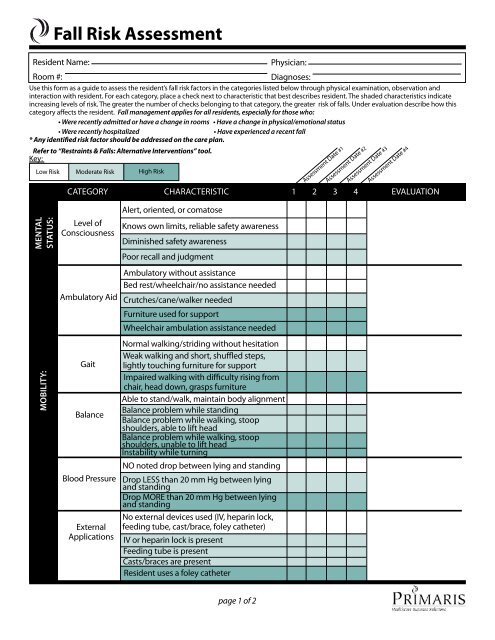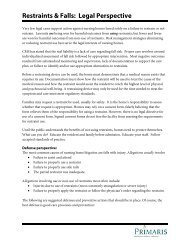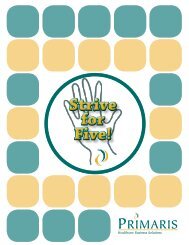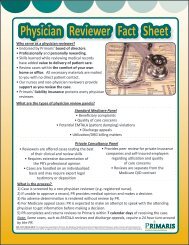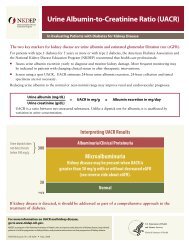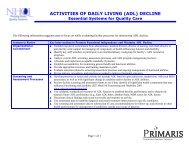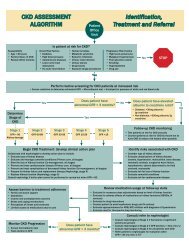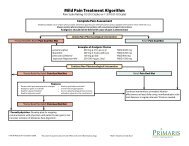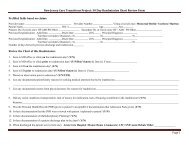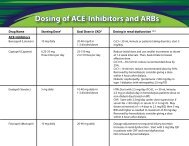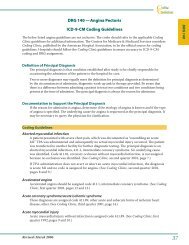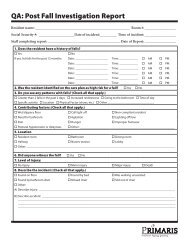Fall Risk Assessment
Fall Risk Assessment
Fall Risk Assessment
You also want an ePaper? Increase the reach of your titles
YUMPU automatically turns print PDFs into web optimized ePapers that Google loves.
<strong>Fall</strong> <strong>Risk</strong> <strong>Assessment</strong><br />
Resident Name:<br />
Physician:<br />
Room #:<br />
Diagnoses:<br />
Use this form as a guide to assess the resident’s fall risk factors in the categories listed below through physical examination, observation and<br />
interaction with resident. For each category, place a check next to characteristic that best describes resident. The shaded characteristics indicate<br />
increasing levels of risk. The greater the number of checks belonging to that category, the greater risk of falls. Under evaluation describe how this<br />
category affects the resident. <strong>Fall</strong> management applies for all residents, especially for those who:<br />
• Were recently admitted or have a change in rooms • Have a change in physical/emotional status<br />
• Were recently hospitalized<br />
• Have experienced a recent fall<br />
* Any identified risk factor should be addressed on the care plan.<br />
Refer to “Restraints & <strong>Fall</strong>s: Alternative Interventions” tool.<br />
Key:<br />
Low <strong>Risk</strong><br />
Moderate <strong>Risk</strong><br />
High <strong>Risk</strong><br />
<strong>Assessment</strong> Date #1<br />
<strong>Assessment</strong> Date #2<br />
<strong>Assessment</strong> Date #3<br />
<strong>Assessment</strong> Date #4<br />
Category CharacteristiC 1 2 3 4 Evaluation<br />
Mental<br />
Status:<br />
Mobility:<br />
Level of<br />
Consciousness<br />
Ambulatory Aid<br />
Gait<br />
Balance<br />
Blood Pressure<br />
External<br />
Applications<br />
Alert, oriented, or comatose<br />
Knows own limits, reliable safety awareness<br />
Diminished safety awareness<br />
Poor recall and judgment<br />
Ambulatory without assistance<br />
Bed rest/wheelchair/no assistance needed<br />
Crutches/cane/walker needed<br />
Furniture used for support<br />
Wheelchair ambulation assistance needed<br />
Normal walking/striding without hesitation<br />
Weak walking and short, shuffled steps,<br />
lightly touching furniture for support<br />
Impaired walking with difficulty rising from<br />
chair, head down, grasps furniture<br />
Able to stand/walk, maintain body alignment<br />
Balance problem while standing<br />
Balance problem while walking, stoop<br />
shoulders, able to lift head<br />
Balance problem while walking, stoop<br />
shoulders, unable to lift head<br />
Instability while turning<br />
NO noted drop between lying and standing<br />
Drop LESS than 20 mm Hg between lying<br />
and standing<br />
Drop MORE than 20 mm Hg between lying<br />
and standing<br />
No external devices used (IV, heparin lock,<br />
feeding tube, cast/brace, foley catheter)<br />
IV or heparin lock is present<br />
Feeding tube is present<br />
Casts/braces are present<br />
Resident uses a foley catheter<br />
page 1 of 2
<strong>Fall</strong> <strong>Risk</strong> <strong>Assessment</strong><br />
page 2 of 2<br />
Resident Name:<br />
Room #:<br />
Physician:<br />
Diagnoses:<br />
Key:<br />
Low <strong>Risk</strong><br />
Medical Status/<br />
History:<br />
Moderate <strong>Risk</strong><br />
Category CharacteristiC 1 2 3 4 Evaluation<br />
<strong>Fall</strong> History<br />
Medications<br />
Continence<br />
Status<br />
Vision/Hearing<br />
Predisposing<br />
Diseases/<br />
Conditions<br />
High <strong>Risk</strong><br />
NO falls in past 3 months<br />
1-2 falls in past 3 months<br />
3 or more falls in past 3 months<br />
Respond below based on these medications:<br />
anesthetics, antihistamines, antihypertensives,<br />
antiseizures, benzodiazepines, cathartics, diuretics,<br />
hypoglycemics, narcotics, psychotropics, sedatives/<br />
hypnotics<br />
Currently takes none of these medications<br />
Currently takes 1-2 of these medications<br />
Currently takes 3-4 of these medications<br />
A change in medication and/or dosage in<br />
past 5 days<br />
Ambulatory/continent<br />
Wheelchair or ambulatory aid/continent<br />
Ambulatory/incontinent<br />
Wheelchair or ambulatory aid/incontinent<br />
Adequate (with or without glasses/hearing<br />
aid)<br />
Poor (with or without glasses/hearing aid)<br />
Legally Blind or very hard of hearing/deaf<br />
Respond below based on these conditions:<br />
hypotension, vertigo, CVA, Parkinson’s, loss of<br />
limb(s), seizures, arthritis, osteoporosis, fractures,<br />
dementia, delirium, anemia, wandering, anger<br />
None present<br />
1-2 present<br />
3 or more present<br />
<strong>Assessment</strong> Date #1<br />
<strong>Assessment</strong> Date #2<br />
<strong>Assessment</strong> Date #3<br />
<strong>Assessment</strong> Date #4<br />
1.<br />
Assessor Name:<br />
Date:<br />
2.<br />
Assessor Name:<br />
Date:<br />
3.<br />
Assessor Name:<br />
Date:<br />
4.<br />
Assessor Name:<br />
Date:<br />
Document available at www.primaris.org<br />
MO-09-09-NH March 2009 This material was prepared by Primaris, the Medicare Quality Improvement Organization for Missouri, under contract with the Centers for Medicare &<br />
Medicaid Services (CMS), an agency of the U.S. Department of Health and Human Services, and adapted from LHCR. The contents presented do not necessarily reflect CMS policy.


